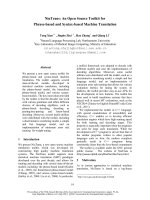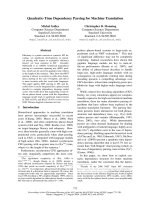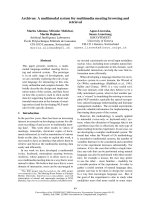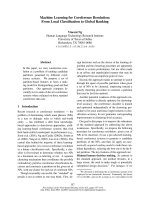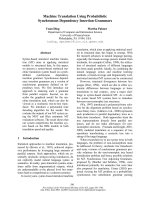Báo cáo khoa học: "Machine Aided Error-Correction Environment for Korean Morphological Analysis and Part-of-Speech Tagging" pptx
Bạn đang xem bản rút gọn của tài liệu. Xem và tải ngay bản đầy đủ của tài liệu tại đây (350.18 KB, 5 trang )
Machine Aided Error-Correction Environment
for Korean Morphological Analysis and Part-of-Speech Tagging
Junsik Park, Jung-Goo Kang, Wook Hur and Key-Sun
Choi
Center for Artificial Intelligence Research
Korea Advanced Institute of Science and Technology
Taejon 305-701, Korea
{jspark,jgkang,hook,kschoi)@world.kaist.ac.kr
Abstract
Statistical methods require very large corpus
with high quality. But building large and fault-
less annotated corpus is a very difficult job.
This paper proposes an efficient method to con-
struct part-of-speech tagged corpus. A rule-
based error correction method is proposed to
find and correct errors semi-automatically by
user-defined rules. We also make use of user's
correction log to reflect feedback. Experiments
were carried out to show the efficiency of error
correction process of this workbench. The re-
sult shows that about 63.2 % of tagging errors
can be corrected.
1 Introduction
Natural language processing system using cor-
pus needs the large amount of corpus (Choi et
al., 1994), but it also requires the high quality.
The process of making the general annotated
corpus can be viewed as Figure 1. There are
some difficulties in processing the annotated
corpus. First, the number of items in a dictio-
nary is not so large. The second problem is in
the difficulty of modifying the errors produced
by automatic tagging. Manual error correction
would require large amount of costs, and there
may still remain errors after correcting process.
There were also researches about automatic cor-
rection, but they had problems about the side-
effects after automatic error correction (Lee and
Lee, 1996; Lim et al., 1996).
In this paper, we will integrate the morpho-
logical analysis and tagging, and provide inter-
active user interface. User gives the feedback
to resolve the ambiguities of analysis. To re-
duce the cost and improve the correctness, we
have developed an environment which is enable
to find errors and modify them.
In the following section, related works are de-
scribed. In section 3, we propose our model.
Then, implementation and experiment results
are explained. Finally, discussion is followed.
2 Related Works
An automatic tagging is prone to errors that
cannot be avoidable due to the lack of over-
all linguistic information. To model the au-
tomatic error-detection process, the statistical
approach of detecting tagging error has been
developed (Foster, 1991). In this section,
we will describe some approaches about rule-
based error correction method for Korean part-
of-speech(hereafter, "POS") tagging system.
2.1 Transformation-Based
Part-of-Speech Tagging System
(Lim et al., 1996) proposed tagging system that
uses word-tag transformation rules dealing with
agglutinative characteristics of Korean, and also
extends the tagger by using specific transforma-
tion rule considering the lexical information of
mistagged word.
General training algorithm of the transforma-
tion rule (Brill, 1993) is as follows:
1. Train initial tagger on initial training cor-
pus Co.
2. Make Confusion matrix with the result of
comparing the current training corpus Ci
(initially, i 0) and C~, the output of a
manual annotation on Co.
3. Extract rules correcting the errors of Con-
fusion matrix best.
4. Apply the extracted tagging rules to the
training corpus Ci and generate improved
version Ci+l.
5. Save the rule and increase i.
1015
dt~umenl
knowledge
program
4
I
/
i
/
/
s /
I User 1
Aolomalk rer~or correction
f
Manual ~rror Correction
Figure 1: Process of making part-of-speech tag annotated corpus
6. Repeat steps 2 to 5 until frequency of error
correction, which is done by rules found in
the previous step, is less than threshold.
2.2 Rule-based Error Correction
This method (Lee and Lee, 1996) is based
on Eric Brill's tagging model (Brill, 1993).
This tagging system is a hybrid system using
both statistical training and rule-based training.
Rule-based training is performed only on the
statistical tagging errors. The rules are learned
by comparing the correctly tagged corpus with
the output of tagger. The training is leveraged
to learn the error-correction rules.
3 Proposed Model
3.1 The Causes of Part-of-Speech
Tagging Error
We will mention important causes to make POS
tagging errors. The first cause comes from the
low accuracy at tagging unknown words, since
assigning the most likely tag for unknown words
cannot be expected to give a good result. Sec-
ond, the linguistic information reflects only the
morpheme concatenation, as mentioned in the
previous section. Especially, errors occur be-
cause of the complex morphological characteris-
tics of Korean. Third, the ambiguities of mean-
ings cannot be resolved, since tagger would not
distinguish them in the morphological level.
3.2 Processing Unknown Words
Some of the tagging errors come from the un-
known word - absence of the word entry in the
dictionary. If at least one sequence of morpho-
logical analysis can produce sequence of mor-
phemes registered in the dictionary, the un-
known word identification routine does not work
even if other sequence contains unknown word.
If no sequence is successful, then the system sug-
gests the possible POS-tagged unknown words.
In our system, if the morphological analyzer
cannot find that all morphemes are in the dic-
tionary, unknown words are supposed to be in-
cluded in the word. Then, the user adds the
unknown words into the dictionary with dictio-
nary manager, if any. After adding the words,
morphological analyzer is called once again. Be-
cause the user adds the identified unknown
words into the dictionary, morphological over-
analysis can be avoided.
3.3 Correction of Errors
The result produced by any tagger will contain
errors, and correcting these errors would cost
very much. Hence, it would be helpful to correct
tagging errors using a system which finds errors
and correct them. To correct errors in this pro-
posed model is defined first to suggest candidate
tags to the user and then to find words which
is likely to be wrong tagged.
Correction rule
1016
and
manual correction log are
necessary for au-
tomatic error detection and candidate sugges-
tion. Rule-based method is a way of finding
the wrong tags with exact match using the pre-
described rule and suggestion pair. The correc-
tion rules are in the form of:
(<current morpheme>
< current tag>)*/position of wrong mor-
pheme or tag/corrected morpheme or ta 9
where • means the repetition. Four kinds of
operators can be used in current morpheme or
tag.
• Don't Care(.) indicates that matching
with all morpheme or tag is permitted. If
we replace all the tag a after noun word
with tag/3, the rule ', <
noun > * < a >
/4/</3 >' is used.
• Or(I ) allows to match any one of the ex-
pressions. If we replace all the tag a after
common or proper noun word with tag/3,
the rule ', <
noun > I < propernoun >
• < a >/4/</3 >' is used.
• Closure(-{-) matches only the content be-
fore "+". If we replace all the tag a af-
ter common noun(tagged as 'ncn', 'ncpa',
'ncps'), with tag /3, the rule,
'*nc + * <
a >/4/</3 >' is sufficient.
• Not(!) matches except expressions follow-
ing "!" If we replace all the tag except
a after noun word with tag a, the rule
'* <
noun
> *! < a > /4/ < a >' is
used.
For example, the following rule can replace all
the tag 'jcs' before the word "-~ r%(doeda)" with
'jet'.
', jcs ~ (doe) pvg / 2 / jcc'
Another is the method of using manual cor-
rection log. Errors which are not detected by
correction rules should be corrected by human
tagger. The result of correction is compiled
for the next time. Manual log is composed
of part of error and part of suggestion. For
example, when we change "u]-~(da'un)/ncpa"
to "~(dab)/xsm-t-t-(n)/etm", the entry will
be 'da'un/ncpa, dab/xsm+n/etm'. We can
adapt the entry to the augmented case,
such as '~(saram)/ncn+da'un/ncpa', '2
,-7, (hag'gyo)/ncn+da'un/ncpa'.
Correction rule can apply to the many kinds
of word phrase; while manual log is concerned
about only one instance of word phrase. With
the manual correction logs, many repetitive er-
rors in a document can be remedied.
4 Implementation
We have implemented error-correction environ-
ment to provide the human tagger with the
interactive and efficient tagging environment.
The overall structure of our environment is
shown in Figure 2.
The process of making POS-tagged docu-
ments in this environment is as follows:
1. Identify unknown words through morpho-
logical analysis.
2. Add unknown word to the dictionary.
3. Repeat morphological analysis using up-
dated dictionary until no more unknown
word is found.
4. Run automatic POS tagging.
5. Detect unknown word error and suggest a
correct candidate word.
6. Act according to reaction of human tagger
- approving modificaton or not, receiving
direct input from the human tagger.
7. Repeat steps 5 and 6 with automatic error
correction using rules and correction logs
so that incremental improvement of tagging
accurarcy can be achieved.
8. Correct manually, if there is any error,
which is not detected.
9. Save what the human tagger corrected at
step 8, and start detecting errors and give
suggestion on the POS-tagged document,
with manual log.
10. If unknown word exists in the result from
step 9, save the result in the dictionary;
otherwise, add it to the manual log.
11. Repeat steps 8 and 10 until the human tag-
ger finds no error in the POS-tagged docu-
ment.
Figure 3 shows the Tagging Workbench.
1017
editor
Figure 2: The Structure of Proposed Environment
~e~l~l ~'1~t:
~ ~tt~c,.~,,,ca ~.~ :"~.i '~":":'-: ""
IIIvg"G II l'illx°%~llP~-=~lll
~[ ~
:"'"
~"
~;:& ~£?;.~,'~i~,~;~;~-:'~
'I .~_~ _~ ~:
Lh~::
,:'d'
.:'g~:.~:. ~,'~ ~:,;~::~. H~ : :. ~.~,~ ~ - .o ~,~ t
1 21f~:: ;~. ~ !;:~~y~ ~:~"~:r~A~ " t ~)~ ~
Figure 3: Tagging Workbench
correction
7O
60
55 L
50
45
40
35
30
I I I I I I
I J r I
document
5 Experiments and
Results
We have experimented on the documents, us-
ing morphological analyzer and tagger (Shin et
al., 1995). The correction log of one document
affects the tagging knowledge base. Then, the
next tagging process is automatically improved.
In the experimental result, error elimination
rates are evaluated.
The result of experiment is in Figure 4. In
Figure 4, automatic correction means the right
correction made by error detection using rule
and manual correction log. Manual correction
means the correction made directly by user. We
can see that the rate of automatic correction
increased, while that of manual correction de-
Figure 4: Comparison between automatic and
manual correction
creased.
We can correct about 7% of total errors by
resolving unknown words. With the increasing
number of entries, the probability of unknown
word occurrence will decrease.
6 Conclusion
As the researches on the basis of corpus have
become more important, constructing large an-
notated corpus is a more important task than
ever before. In general, constructing process
of POS-tagged corpus consists of morphological
1018
analysis, automatic tagging and manual correc-
tion. But, manual error correction step requires
a large amount of costs.
This paper proposed an environment to re-
duce the cost of correcting errors. In the mor-
phological analysis process, we have eliminated
the errors of unknown words, and find errors
with error correction rules and manual correc-
tion log, suggesting the candidate words. Users
can describe error correction rule easily by sim-
plifying the format of error rule. As a result of
experiment, about 63.2% of tagging errors were
corrected.
Our environment needs further enhance-
ments. One is the need of observation on the
pattern of errors to make rules so that accuracy
may be improved, and the other is the efficient
use of manual logs; currently we use pattern
matching. More general rules could be found
by expressing the manual logs in other ways.
References
E. Brill. 1993. "A Corpus-Based Approach to
Language Learning".
Ph.D. Thesis, Dept. of
Computer and Information Science, Univer-
sity of Pennsylvania.
K. Choi, Y. Han, Y. Han, and O. Kwon.
1994. "KAIST Tree Bank Project for Korean:
Present and Future Development".
SNLP,
Proceedings of International Workshop on
Sharable Natural Language Resources,
pages
7-14.
G.F. Foster. 1991. "Statistical Lexical Disam-
biguation".
M.S. Thesis, McGill University,
School of Computer Science.
G. Lee and J. Lee. 1996. "Rule-based error cor-
rection for statistical part-of-speech tagging".
Korea-China Joint Symposium on Oriental
Language Computing,
pages 125-131.
H. Lim, J. Kim, and H. Rim. 1996. "A Korean
Transformation-based Part-of-Speech Tagger
with Lexical information of mistagged Eo-
jeol".
Korea-China Joint Symposium on Ori-
ental Language Computing,
pages 119-124.
J. Shin, Y. Han, Y. Park, and K. Choi. 1995.
"A HMM Part-of-Speech Tagger for Korean
with wordphrasal Relations".
In Proceedings
of Recent Advances in Natural Language Pro-
cessing.
1019


